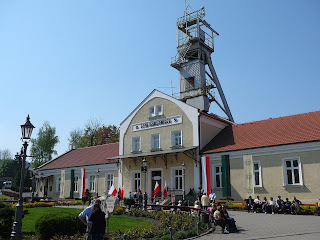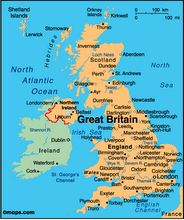 Monday
MondayOn Monday the two of us got going early to explore more of the Old Town. We wandered through the Princes Gardens past the majestic Ross Fountain. The Ross Fountain is a huge iron fountain from the mid-19th century. Figures depicted on the fountain include mermaids and four females depicting science, the arts, poetry and industry.
We were pretty hungry, so our first stop was the Elephant House Cafe where, as mentioned in part 1 of this blog, J K Rowling used to come and sit with her laptop while she was writing the early Harry Potter books. Back when she was very poor, it made more sense for her to sit in the warm cafe all day rather than heat her own house. The back of the cafe has great views of Edinburgh Castle, Greyfriars cemetery and a large public school for orphans, which looks rather a lot like Hogwarts, which may have been inspiration for her writing.
There was a long queue in the cafe, as it is very popular, but once we were served we had a delicious breakfast, while sitting at the back of the cafe with a lovely view out to the castle. Tim had a bacon and sausage roll and a hot chocolate and Megan had an apricot danish and an enormous pot of coffee. If you're in Edinburgh, definitely pop in for a snack, it's awesome.
After breakfast we walked down to the Grassmarket area, which is renowned for its bars and nightclubs. It was re-developed in a 2008 project costing £5 million, making it more pedestrian friendly with the extension of large pavement cafe/bar areas. Needless to say, it was a little early, even by Scotland's standards, for much action in the bars.
We enjoyed looking in some of the shops as we made our way back up to the Royal Mile, including a little souvenir shop called "Thistle Do Nicely" - brilliant. We browsed several souvenir shops on the Royal Mile and eventually had success finding both a fridge magnet for Megan's growing collection and a wee ornamental figurine of a bagpiper to go on our little shelf of nik-naks.
Having heard a bit of information about St Giles' Cathedral during our walking tour, we decided to pop in and have a look. The cathedral, which is actually not a cathedral (by British law a church needs to have a bishop to be called a cathedral), is a Church of Scotland place of worship, which decorates the midpoint of the Royal Mile. The church was very pretty, particularly the Thistle Chapel, which is where Scottish knights (such as Sir Sean Connery) are knighted by the Queen. The chapel is one of only two places on the planet, so we are told, where you will see a carving of an angel playing bagpipes...
Unfortunately Megan had to return to Julia and Casey's for a couple of hours to sort out some work matters. Meanwhile Tim continued down the to the end of the Royal Mile, where Holyrood Palace is situated. The Palace of Holyroodhouse is the official (government-owned) residence of the Monarch of the United Kingdom in Scotland. Founded as a monastery by David I, King of Scots in 1128, it has served as the principal residence of the Kings and Queens of Scots since the 15th century. Queen Elizabeth II spends one week in residence at Holyrood at the beginning of each summer, to host garden parties and official ceremonies. She then continues to Balmoral Castle (which she owns), which is further north in Scotland, for her annual two-month summer holiday. The palace is usually open for public tours but it was closed while we were in town - perhaps in readiness for Her Majesty's visit...
Opposite the Holyrood Palace at the foot of the Royal Mile is the new Scottish Parliament building. Scotland has its own parliament which deals with "Scottish matters", apart from big issues such as taxation, defence, etc, which are handled through Westminster. Construction of the new parliament building began in June 1999 and it was officially opened in October 2004. It is rather unusual looking, particularly for a parliament building - it has sticks all over the front walls and it is very "modern" looking. Needless to say, its appearance has been very controversial since it opened five years ago.
Tim continued back up the Royal Mile and popped in to Greyfriars Bobby's bar to read the newspaper and rest his legs. From there, Tim walked down to the New Town and met Megan outside the National Art Gallery. There was a bagpiper and some random crazy dancers performing in the busy little square, which made it a nice spot to sit in the sun. We had a look around the art gallery, which for its relatively small size, punches well above its weight! It has a fairly large collection squeezed into a small gallery, including works by Raphael, Monet and Van Gogh! To make it even more appealing, it's free! Definitely worth a look as well.
Just along from the art gallery in the Princes Street Gardens is an enormous monument dedicated to Sir Walter Scott. Scott was a prolific Scottish historical novelist and poet, extremely popular throughout Europe during his time (1771-1832). The Scott Monument is a Victorian Gothic monument, standing at just over 200 feet high. It has a series of viewing decks reached by a number of narrow spiral staircases giving panoramic views of central Edinburgh and its surroundings. We sat on the grass beneath the Scott Monument and ate an ice-cream in the sunshine - perfect.
We walked back through the shops of George Street and on to Julia and Casey's place, where we hung out with them until it was time to catch our train back to London. We had a fantastic time in Edinburgh, it is a beautiful and vibrant city and hopefully we will get back there one day. Thank you so much to Julia and Casey who played not only host and chef extraordinaire, but also travel guide, and made our stay really fun.

Ross
Fountain
in Princes
Gardens

Megs at
Elephant
House cafe

Tim by
Bobby's
statue

Thistle
Do Nicely -
mwah ha
ha

Former torture
cross - Royal
Mile

Statue of
Adam Smith,
most famous
economist of
all

Building
on Royal
Mile

Clock
Tower

Royal Mile
pubs

Royal
Mile

Holyrood
Palace

New
Scottish
Parliament
Building

Balmoral
Hotel

St Giles'
Cathedral

Royal
Mile again

Views
from art
gallery

National
Art Gallery
of Scotland

Scott
Monument










































